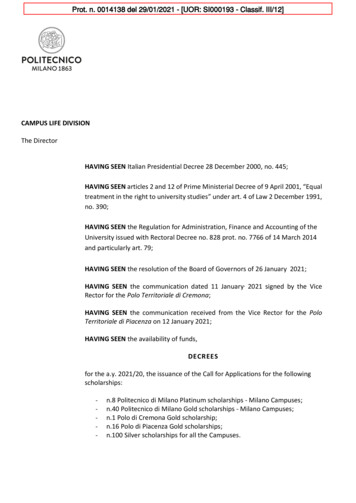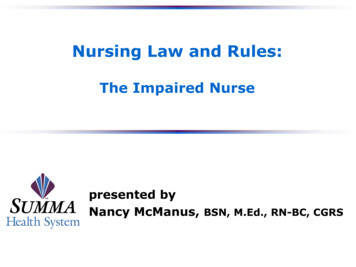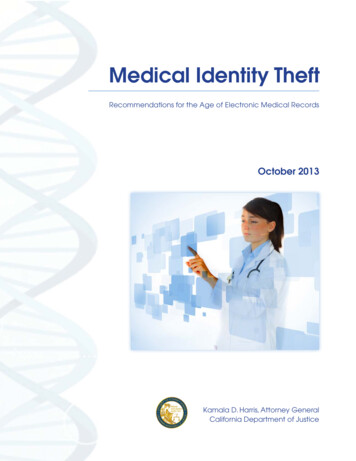
Transcription
“It’s stressful having all these phones”:Investigating Sex Workers’ Safety Goals, Risks,and Practices OnlineAllison McDonald, University of Michigan; Catherine Barwulor, Clemson University;Michelle L. Mazurek, University of Maryland; Florian Schaub, University of Michigan;Elissa M. Redmiles, Max Planck Institute for Software urity21/presentation/mcdonaldThis paper is included in the Proceedings of the30th USENIX Security Symposium.August 11–13, 2021978-1-939133-24-3Open access to the Proceedings of the30th USENIX Security Symposiumis sponsored by USENIX.
“It’s stressful having all these phones”:Investigating Sex Workers’ Safety Goals, Risks, and Practices OnlineAllison McDonaldUniversity of MichiganFlorian SchaubUniversity of MichiganCatherine BarwulorClemson UniversityElissa M. RedmilesMax Planck Institute for Software SystemsAbstractWe investigate how a population of end-users with especially salient security and privacy risks — sex workers —conceptualizes and manages their digital safety. The commercial sex industry is increasingly Internet-mediated. As such,sex workers are facing new challenges in protecting their digital privacy and security and avoiding serious consequencessuch as stalking, blackmail, and social exclusion. Throughinterviews (n 29) and a survey (n 65) with sex workers inEuropean countries where sex work is legal and regulated,we find that sex workers have well-defined safety goals andclear awareness of the risks to their safety: clients, deficientlegal protections, and hostile digital platforms. In response tothese risks, our participants developed complex strategies forprotecting their safety, but use few tools specifically designedfor security and privacy. Our results suggest that if even highrisk users with clear risk conceptions view existing tools asinsufficiently effective to merit the cost of use, these tools arenot actually addressing their real security needs. Our findingsunderscore the importance of more holistic design of securitytools to address both online and offline axes of safety.1IntroductionIn recent years, there has been a massive increase in the number of sex workers working partly or exclusively through theInternet [15]. Sex work is prohibited or heavily regulatedin most countries, resulting in many sex workers needing tomanage digital and physical risks carefully while carryingout their work. Even in countries where sex work is legal, theprofession is heavily stigmatized [63], and working legallymay not be an option for all workers [59, 69]. Furthermore,sex work can be a risky business: in person, sex workersmay face aggressive or violent clients, and police or immigration action [37, 59]; online, sex workers may face doxxing,harassment, or having their content stolen or misused [38].Much like other end-users — but unlike previously studiedat-risk occupations such as journalists [50] — sex workersUSENIX AssociationMichelle L. MazurekUniversity of Marylandrarely receive specialized digital security and privacy trainingor customized security tools.Further, sex workers make up a sizable portion of the population: an estimated 42 million people are engaged in sexwork worldwide [43, 56], spanning all genders, ethnicities,and socioeconomic backgrounds [35, 54, 64]. A growing bodyof sociological and HCI research has looked at how the Internet has impacted the working conditions of sex workers,including how they find and interact with clients [7, 11], conduct their businesses [63, 64], and even the forms of sex workthey do (for example, supplementing in-person sex work withcamming: live performance of sex acts on camera) [15,39,65].Yet, while many recent studies on digitally-mediated sex worktouch upon safety management [63, 64], none, to our knowledge, center the digital safety experiences and technical needsof this high-risk population.Our research goal is to elucidate how sex workers managetheir digital privacy and security. By understanding how apopulation that knowingly operates in risky physical, legal,and social contexts makes decisions around digital privacyand security, where the consequences of unwanted exposurecan be significant, we hope to better understand (1) how technology can better address the specific safety needs of thisparticular population, (2) how awareness of serious risk influences digital security and privacy behavior, and (3) whetherexisting safety strategies and tools leave some needs unmetor force unwanted trade-offs. A better understanding of howthis population manages digital safety can also inform ourapproach to improving digital security for end-users morebroadly.Through 29 semi-structured interviews with sex workersin Germany and Switzerland and a survey of 65 sex workersin Germany, Switzerland, and the UK (all countries in whichsex work is legal but regulated), we explore sex workers’ selfdefined safety goals, the risks they identify to those goalsin terms of both adversaries they frequently defend againstas well as the digital tools that make protecting themselvesdifficult, and the concrete strategies and tools they use toprotect themselves against those risks.30th USENIX Security Symposium375
Safety for our participants encompasses multiple axes, including physical safety, financial security, having and enforcing clear boundaries, respect, privacy, legality, and access toa community of sex workers. Each of these axes of safety isdependent on others; a threat to one axis may increase therisks from another. For example, a sex worker failing to keeptheir legal name private may increase chances of physicalthreats like stalking or blackmail.Our participants describe complex safety strategies, such asthe use of multiple devices, self-censorship online, and the creation of support communities, e.g., to warn each other aboutdangerous clients. Yet, despite being aware of risks, and despite the serious consequences of failing to protect themselves,few participants engage with traditional tools specifically designed for privacy and security such as privacy settings, Tor,encrypted chat platforms, and password managers. Sex workers view these tools as lacking sufficient efficacy to addresstheir risks or merit the effort of use. Instead, our work suggests the need for a more comprehensive re-imagining ofwhat it means to be safe online, beyond individual tools andsettings, including scaling the home-grown protections thathigh-risk users such as sex workers develop for themselvesout of necessity, such as multiple identities, and protectionsthat address both online and offline axes.2Related WorkDigitally-mediated sex work. Sex work is defined as theexchange of sexual services for money, encompassing a broadrange of services such as escorting (i.e., full-service sex work),erotic massage, porn acting, camming (performing live sexacts on video), phone sex, professional domination (performing the dominant role in a BDSM relationship), and eroticdancing. Sex work is increasingly digitally-mediated, offeringboth new opportunities and challenges [37].Prior work has examined the impact of the Internet on sexwork through an economic lens. In 2011, Cunningham andKendall found that the rise in digital sex work was due to overall increases in the commercial sex market and not from themigration of street-based sex workers to digital spaces [15].Sanders et al. also found that, in 2016, 35% of escorts basedin the U.K. were doing some form of digital sex work in addition to outdoor sex work [63]. Workers engaging in digitallymediated sex work also had higher earnings than outdoor(street) workers [15]. Prior work suggests these economicgains are related to the Internet’s utility as a tool for advertising to clients, allowing sex workers a greater amount ofcontrol over their ads and the clients they accept [7, 11, 64].The Internet has also enabled new forms of sex work thatare entirely digital, like camming [39]. Furthermore, the increased prevalence of the Internet has created new spaces fordigital activism and community among sex workers [22].The Internet can also reduce sex workers’ risks. Strohmayeret al. describe the ways that sex-worker support services use376digital technologies to better provide services [68], and insubsequent work examined in particular the Bad Client andAggressor List used by sex workers in Canada to share warnings about potentially dangerous clients with one another [67].Additional work shows that digital mediation of sex work reduces rates of law enforcement interactions, in turn loweringthe risk of harassment or arrest [11, 15].Nonetheless, sex workers still experience risks online andoffline, and the Internet is increasingly intertwined with theirsafety management strategies. Several studies have discussedhow sex workers manage risk via the Internet. Moorman andHarrison examine Backpage ads to learn how sex workers inthe U.S. manage risk through carefully crafted ad language,and find that risk management differs across race and gender,with Black women and transgender sex workers exhibitingthe most risk management [54]. Sanders et al. find in theirsurvey of U.K.-based sex workers that most (80%) had beenrecent victims of crime, and enumerate ways they manage riskthrough strategies like using pseudonyms on digital platforms,screening for bad clients in forums, and relying on socialmedia to have safety check-ins with friends or partners [64].In this work, we build on existing knowledge of sex work riskmanagement to hone in on the relationship between safetygoals and risk management strategies, focusing on wheredigital safety strategies succeed and fail.30th USENIX Security SymposiumDigital privacy & security. There is an extensive body ofresearch on tools and strategies for digital privacy and security.Multiple studies have examined the usability of various security tools and privacy enhancing technologies like encryptedchat (e.g., [1, 2]), Tor (e.g., [25, 72]), passwords and password managers (e.g., [9, 34]), and two-factor authentication(e.g., [14, 21]). General themes from these studies suggestthat managing complex systems (as privacy and security toolsoften are) is difficult for many users, and the trade-offs usersmake based on perceived costs and perceived risks may leadto low adoption of even well-designed tools [8, 31, 62]. In thiswork, we examine whether users who perceive their digitalrisks more concretely, and who have arguably more severerisks, utilize more or different tools and protective behaviors.Other work has focused specifically on how marginalizedor otherwise high-risk populations manage privacy and security. Lerner et al. found that among transgender people, theInternet provided significant benefits in terms of activism andpromoting representation of trans people, while creating newrisks like blackmail and doxxing [42]. Guberek et al. studiedprivacy and security behaviors of undocumented immigrants,finding that participants took few concrete steps to protecttheir digital privacy and security [27], while Simko et al. examined U.S. refugees’ digital privacy and security, findingthat cultural differences impacted knowledge of digital risks,as well as the usability of security mechanisms like accountrecovery questions [66]. In prior work examining a high-riskoccupation that depends on the Internet, McGregor et al. stud-USENIX Association
ied journalists’ digital protective strategies and found thatparticipants stopped using or were unable to use some securetools because they were disruptive to or incompatible withtheir journalistic workflow, and that using secure tools withsources was challenging because both parties needed to usethe tool for it to be effective [50]. Building on this prior work,we examine a high-risk population whose members frequentlyhave multiple, intersecting high-risk identities, including gender identity [35] and immigration status [69]. Like journalists,sex workers often use the Internet for work, but without thespecialized training or tools journalists often have.Additional prior work has examined how technology isused in relationships with intimate partner violence (IPV) tocreate harm [24, 30, 46], while yet other work has examinedend-users’ security and privacy considerations during onlinedating [13, 26]. Our work focuses on digital security andprivacy within commercial, regulated sexual contexts ratherthan non-commercial relationship contexts, though some risksmay overlap.3MethodsWe seek to understand (1) sex workers’ safety goals; (2) theprivacy and security challenges sex workers face in achievingthose goals; and (3) the strategies workers use to mitigatethose risks and achieve their safety goals. To answer ourresearch questions, we conducted, in late 2018 and early 2019,interviews (n 29) and surveys (n 65) with sex workers inEuropean countries in which sex work is legal.Ethical considerations. As our participants are membersof a high-risk population, we not only consulted with an ethicsreview board but also hired a sex worker to review our studymaterials for ethics and appropriateness. Further, we took careto protect participant privacy and ensure, as much as possible,that our work does not risk identifying participants. Specifically, we (1) collect no personally identifiable information,including collecting no demographic data, and (2) use end-toend encrypted tools in all study communications. As we didnot collect participants’ demographics, we use gender-neutralpronouns for all participants throughout the paper.3.1Participant RecruitmentOur recruitment strategy was designed to capture a broadrange of sex workers and their experiences, within legal, regulated contexts. We recruited interview participants by distributing recruitment flyers, both in English and German, atbrothels in multiple cities, at multiple points of time, in Germany and Switzerland. We further contacted brothels andsex work organizations via email and phone calls. Organizations that were willing distributed our advertising materials totheir constituents. Lastly, participants were recruited throughUSENIX Associationsnowball sampling, where participants recommended othersex workers. Participants were incentivized with an additional10 Euro/CHF for referrals. Hard-to-reach populations like sexworkers are often studied via such participant-driven sampling [4, 36, 51]. However, such sampling methods can limitgeneralizability. We used our multi-method recruitment approach to maximize generalizability — fewer than 10% of ourparticipants came from snowball sampling.Participants signed up for the study via an online form.They were given the option of creating an anonymous ProtonMail account for scheduling and for compensation, or providing an email address of their choosing. Overall, the recruitment process for this study took over four months; ourexperience collecting data is described in more detail in [60].Participant descriptives. While we did not collect demographic information to ensure the anonymity and establishtrust with our participants, many participants mentioned aspects of their identity during conversation. We can thereforedescribe at a high level the plurality of identities that our participants held, which shows that our sample, much like thesex worker population in Eupope [69], is diverse across manyidentities. Our sample contained sex workers who identify asboth men and women, and not all of our participants identifyas cisgender. Our sample contained participants that are immigrants from Eastern Europe, North America, and Africa,and participants who had varying levels of work authorization.Not all participants were white. Finally, the sex workers wespoke to varied in age and work experience; some had justbegun working in the last year, while others had been workingfor multiple decades.3.2Interview Data CollectionInterview protocol. In our interviews, we sought to understand the safety goals, risks, and protective behaviors ofour participants. Participants were first asked backgroundquestions to understand the type of sex work the participantperformed and how they typically used the Internet in theirwork and personal life. Next, we probed their experiences ofsafety, asking questions such as “What is safety to you as asex worker? How do you define safety?” We then probed theirperceived risks (e.g., whether they have had a negative experience online, what types of attacks and attackers they aim toprotect themselves against). We then explored participants’strategies for maintaining their online safety (e.g., “Wouldyou say you do anything in particular to maintain your safetyonline?”), including probing specific behaviors such as useof security and privacy settings. Lastly, we asked participantsquestions about additional sex-work-related topics, outsidethe scope of this research paper.Interview procedure. Participants chose to be interviewedeither via chat, voice, or video. As such, there are quotes that30th USENIX Security Symposium377
may contain text-speak or emojis. Based on each participant’slanguage preference, interviews were conducted in English orGerman by members of the research team fluent in that language. Interviews lasted on average 60 minutes, ranging fromapproximately 30 minutes to 2 hours. For participant safety,all interviews were conducted using private paid “rooms” onAppear.in,1 an end-to-end encrypted communication service.Participants were paid the equivalent of 75USD (75CHFor 60 Euros) in the form of an Amazon gift card or moneytransfer.2 Following each interview session, audio recordingsof the interviews, if applicable, were transcribed in the nativelanguage. German transcripts (both chat and audio) were thentranslated into English for analysis; bilingual members of theresearch team consulted the original German transcripts during analysis to ensure that tone, turns of phrase, and culturalcontexts were captured and included in quotes and coding.3.3Survey Data CollectionAfter conducting interviews, we developed a survey instrument to gain a larger sample size and quantification of thesame topics and emergent themes explored in our interviews.Specifically, we used an open-response question to probe respondents’ definitions of safety: “How do you define safetyas a sex worker? What does it mean for you to be safe?” Fourclosed-response questions asked about respondents’ use ofdifferent digital tools (e.g., encrypted messaging applications,Tor); their use of safety strategies mentioned by interviewparticipants (e.g., “I only communicate with clients on certaindevices, SIM cards, or apps”); and how legalization of sexwork and immigration status affected respondents’ feelings ofsafety.3 Survey participants were recruited from sex workerswho contacted us to participate in the interview after interviews had concluded (early 2019), and were compensated10EUR for roughly a 10-minute survey. As in our interviewstudy, respondents could take the survey in either German orEnglish.3.4AnalysisInterviews were analyzed using an open-coding process.Three co-authors randomly selected four interview transcriptsto identify emerging themes and create a thematic frameworkfor the interview data. After creating a codebook, two of theco-authors independently coded 10 interviews to reach clearerinsights into the interview data. All interview transcripts werethen double-coded, codings were reviewed by the researchersafter every two to three interviews, and any disagreementswere reconciled. Because the interviewers reviewed every1 Appear.inrecently changed its name to Whereby.com.workers in Germany and Switzerland earn between 50 and 600Euros per hour; thus we aimed to compensate them appropriately for theirtime participating in our study.3 The interview protocol, survey questions, and codebook can be found athttps://osf.io/9mj7k/.2 Sex37830th USENIX Security Symposiumindependently-coded transcript together, we do not presentinter-rater reliability [49, 53].Responses to the open-response survey question aboutsafety definitions were similarly analyzed using the samecodebook. The results of our closed-response survey questions are reported descriptively. As this work is exploratoryin nature, we had no hypotheses and thus make no statisticalcomparisons.3.5LimitationsOur results may be limited in their generalizability and byparticipants’ willingness to share sensitive experiences. Whilewe did our best to use many recruitment methods, conductour study in multiple languages and at different sites, use nonjudgmental language, and offer participants a high degree ofprivacy to encourage sharing, we cannot be sure that we exhaustively captured all possible experiences and strategies ofsex workers in countries where sex work is legal. However,our results provide a set of concrete insights into the experiences and safety strategies of a high-risk population, notpreviously studied in the security literature.4ResultsBased on the responses from both interview and survey participants,4 we describe the privacy and security goals of ourparticipants, the threats they see to those goals, and the strategies they use to protect themselves.4.1Definitions of SafetyWe identify seven common safety goals. Most participantsmentioned physical safety, and many talked about financialsecurity, clear boundaries, and privacy. For some respect, legality, and access to community were important safety aspects.The ways that our participants define safety are intimatelyconnected with their digital security needs and guide theirprotective strategies. By considering our participants’ holisticsafety goals [61], we can better understand their decisionmaking processes and unmet safety and security needs. Whilewe describe each safety goal separately, these goals are interconnected and were often discussed together by participants.For example, both financial security and privacy may be necessary to minimize the risk of physical harm.Physical safety. Most participants’ definitions of safety included physical safety, which often encompassed being protected from physical assault or threat of assault by aggressiveclients. As one survey participant stated, safety means “being able to work without fear of abuse or aggression” (S36).4 Weuse participant IDs to refer to interview (P) and survey (S) partici-pants.USENIX Association
That said, not all participants feared for their physical safety.Although we cannot report safety fears by gender due to participant protections, one participant’s response suggested thattheir race and gender impacted their sense of safety: “Since Iam a very privileged white cis male I don’t think about safetyso much.” (S12) This difference in safety concerns across raceand gender is consistent with other studies [54].Many participants discussed physical safety as being related to having the necessary resources — including supplies,a safe physical space in which to work, and access to healthcare and the ability to enforce safe sex practices such as theuse of condoms — to safely do their work. P11 describes:“Safety for me means: I can do my job in an environment that doesn’t endanger me and providesme with the necessary stuff to protect me. I needgloves and condoms, for example. I also like to notbe raped and killed on the job, so I prefer workingin a studio with colleagues present.” (P11)“Safety is knowing. . . that my boundaries won’t getcrossed, like pushed to have unprotected sex. ThatI’ll get paid for what I asked and that the hours willbe clear and done.” (P8)Respect. Many participants connected their safety and wellbeing to being respected by clients and society at large. S10stated that safety means “not feeling that society thinks it’snormal for me to get hurt.” P20 expands on this idea, sayingthat safety is intertwined with being protected from discrimination and stigma:“The absence of fear of suffering personal or financial disadvantages due to one’s activity. . . wherethe rule of law prevails over personal reservations.Working as a [sex worker] should be recognized asa normal job.” (P20)Privacy. Respect and privacy are often linked. P6 says:Some participants described safety as when their protectivestrategies — including digital strategies — were in place (wediscuss protective strategies in more detail in Section 4.3).For example, one participant shared:“Privacy is directly tied in with safety from harassment these days. Safety is about working safe in asociety that treats me with respect and respects myprivacy as well.” (P6)“I’m safe when people know where I am. . . I likewhen the clients send me photos before of thembecause when I don’t know the face of the guy I amvery scared.” (P10)For others, feeling safe is directly connected to their ability to control the privacy of their personal information fromclients and/or from their social networks.Financial security. For many participants, financial security is a primary component of safety. Participants mentionedthat financial security depends on sex workers being compensated fairly and having access to health insurance and othergovernment and social safety nets. Financial security also tiesclosely into physical safety. For example, several participantsmentioned that when they are financially secure, they are ableto turn away clients who make them feel unsafe. For example,S31 explains:“I don’t use drugs, don’t gamble, have no debts, nofinancially needy relatives etc so I feel zero pressureto accept bookings. . . if I had to accept jobs againstmy better judgement eg someone who’s obviouslydrunk or aggressive. or demanding services I don’toffer, I would be unsafe.” (S31)Clear boundaries. Many participants’ definitions of safetyinvolved ideas of boundaries, psychological well-being, and,as S9 put it, “to have control.” Participants reported feeling safe when their physical and sexual boundaries were respected, but also when their personal time was respected, aswell as when digital boundaries they established between theirwork and personal lives were honored. P8 describes:USENIX Association“For me, privacy is when clients don’t know myname or address and can only contact me when Iallow it. . . . An unannounced visit from a friendwould be something nice. An unannounced visitfrom a client would be a catastrophe.” (P14)Many participants worried about being “outed,” or publiclyidentified as a sex worker against their wishes. The potentialconsequences of being outed range from embarrassment toblackmail and threats of physical violence. P10 shared:“I have a friend who [was blackmailed]. And ifshe didn’t pay [the blackmailer], [they] would tellall the . . . neighborhood . . . My friend was born ina Muslim family, so it’s more difficult. . . . If herfamily knows it, and if neighborhood knows it, shesaid to me that it would be the end of social life forher family.” (P10)This demonstrates how closely related privacy and physicalsafety are: if privacy goals are not met, it may lead directly tophysical danger.Legality. For some participants, safety stems from workinglegally and having access to support services:“I want to be recognized as a legit business. I wantto tax my income and also deduct my expenses. I30th USENIX Security Symposium379
want to qualify for social security. I also want asafe way to advertise and find clients. I want to beprotected by law, if a client misbehaves.” (P6)S22 describes how working in environments where clientsfeared law enforcement — because the location where theywere pursuing services was not in compliance with legalregulation — makes their job less safe:“[I want] to work as little as possible in ‘gray / dark’environments, such that customers [don’t] have thefeeling of needing to hide - [then] it is easier for meto vet them ahead of time.” (S22)For some participants, like P6, safety meant being able tocall the police if they had a negative experience or were indanger. However, among our participants the ability to call thepolice safely might depend on whether they were officiallyregistered as a sex worker, which was often, in turn, related totheir immigration and work authorization status. Thus, someparticipants instead described safety as minimizing contactwith the police as much as possible. S2 explains:“One of my sex worker friends is an undocumentedmigrant. . . She has no right to access healthcare.She is very distrustful of police and the authorities.She guards her privacy and anonymity more thanother sex workers I know.” (S2)Access to community. Having access to a support community of other sex workers can also be an important componentof safety. These support communities may be online or offline,as suggested by other work on sex workers [22, 64]. Theseonline spaces can provide emotional or logistical support inthe case of a negative experience, or just a place to feel validated and less isolated. S52 identifies that to feel safe, it isimportant for them to “ensure I get things off my chest. . . withother sex workers in-house or online when I can.”While these communities can provide safety education andresources, participants may face significant barriers to achieving and maintaining them. Policies regulating the use of onlineplatforms for sex-work-related topics, even if not used for sexwork itself, threaten the existence of these communities.4.2Perceptions of RiskWe next discuss the sources of risk identified by our participants. Unsurprisingly, clients pose a significant threat. Risksfrom clients often manifest on multiple safety axes. For example, clients may violate a sex worker’s boundaries by findingtheir personal Facebook. If the sex worker’s legal name is exposed, this can create risks of stalking and blackmail, whichin turn increases risks to their physical security.However, risk also stems from the legal and technical landscape in which sex work is conducted. Laws that regulatesex work (or business more generally) create opportunities38030th USENIX Security Symposiumfor unwanted information exp
erotic massage, porn acting, camming (performing live sex acts on video), phone sex, professional domination (perform-ing the dominant role in a BDSM relationship), and erotic dancing. Sex work is increasingly digitally-mediated, offering both new opportunities and challenges [37]. Prior work has examined the impact of the Internet on sex










